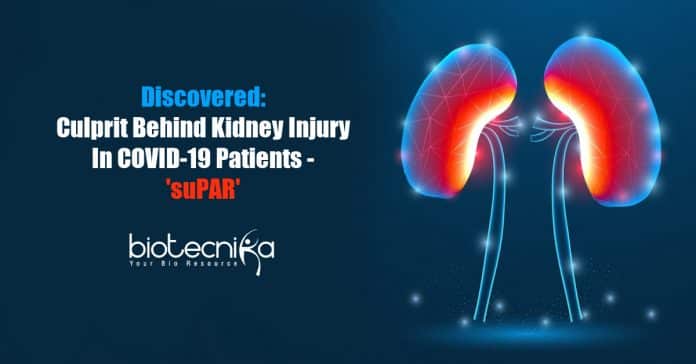‘suPAR’ – the culprit behind kidney injury in COVID-19 patients
In patients admitted in the hospital for COVID-19, Kidney injury is a dreadful complication. More than one 3rd of individuals ending up in the need for dialysis. Additionally, individuals with COVID-19 related kidney injury are at a higher risk of fatality.
Salim Hayek, M.D., senior author of a novel observational study, and a cardiologist, Michigan Medicine, University of Michigan, Frankel Cardiovascular Center stated that they don’t understand why severe COVID-19 patients have a high rate of kidney injury. Though, it is being more clear that a hyperactive immune system plays a significant role in the death rate due to COVID-19, including kidney-related problems.
The results of this multi-center research are released in the Journal of the Society of Nephrology. The levels of a protein in the blood synthesized by immune cells and identified to be associated with inducing kidney disease are really high in individuals hospitalized for COVID-19 and strongly anticipating of kidney injury, according to Salim Hayek and an international team of experts.
The study team tested “suPAR” soluble urokinase plasminogen activator receptor levels in 352 COVID-19 patients.
One-fourth of the patients showed severe kidney injury while hospitalized. The
average suPAR levels in those patients were more than 60% higher than the rest of the patients. In patients with the highest suPAR levels, the chance of requiring dialysis was raised by 20-fold. In general, median suPAR levels for these research participants admitted in hospitals with critical COVID-19 were practically 3 times more than the levels of healthy individuals.Jochen Reiser, M.D., Ph.D., a professor of medicine at Rush University and expert in the biology of suPAR said that SuPAR is an immune-derived circulating factor they have seen add to kidney injury in many individuals. A suPAR response of the innate immune system leading to an increase in blood suPAR levels is produced by RNA viruses such as SARS-CoV-2 and HIV. Kidney cells might be damaged, if there is a hyperinflammatory suPAR reaction.
Determining suPAR levels at healthcare facility admission as a strong predictor for AKI throughout the hospitalization has vital effects for future care said research author Subramaniam Pennathur, M.D., a professor of nephrology, Michigan Medicine.
He further stated that, for instance, obtaining suPAR levels might allow us to risk-stratify, i.e., recognize high-risk patients earlier, and administer a suitable preventative treatment. This approach can decrease AKI risk and improve COVID-19 consequences. The therapies focused on interrupting the suPAR pathway may also be checked out for a preventative and therapeutic alternative for COVID-19 acute kidney injury.
Presently, Hayek is studying exactly how to minimize suPAR levels in patients at a higher threat.
He added that they are planning to launch the first clinical trial targeting suPAR to prevent kidney injury in COVID-19 patients. This approach can be a hopeful method to minimize the problem of kidney disease related to high levels of suPAR in both COVID-19 and non-COVID-19 patients.
Other authors of the study Patrick O’Hayer, Husam Shadid, Pennelope Blakeley, Tariq Azam, Peiyao Zhao, Michael Pan, Lili Zhao, Rodica Pop-Busui, and Hanna Berlin from Michigan Medicine. Frank Tacke and Pinkus Tober-Lau from Charite Universitatsmedizin Berlin. Marius Stauning, Ove Andersen, Izzet Altintas, Jesper Eugen-Olisen, and Jens Tingleff from Copenhagen University Hospital. Evangelos Giamarellos-Bourboulis, Maria Tsilika, Nicky Solomonidi, and Maria-Evangelia Adami from National and Kapodistrian University of Athens. Sven Loosen and Verena Keitel from the University Hospital Düsseldorf. Athanasios Chalkias and Eleni Arnaoutoglou from the University of Thessaly.
‘suPAR’ – the culprit behind kidney injury in COVID-19 patients
Author: Sruthi S






























